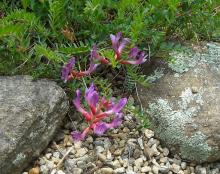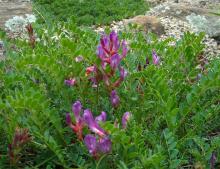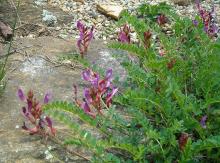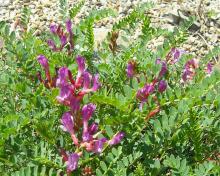What is it? Astragalus? Oxytropis? Which one? It's about 9 years old, from seed, and it's a very beautiful and tractable plant but I lost the label too many years ago.
Comments
Re: Help Me Identify This
I agree it is a charming plant!
Re: Help Me Identify This
What is it? Astragalus? Oxytropis? Which one? It's about 9 years old, from seed, and it's a very beautiful and tractable plant but I lost the label too many years ago.
To assist in the possible identification of this plant, I am uploading some closeup photographs that I took while recently visiting Peter Goerge's fine rock gardens. I haven't looked at it critically to determine whether it is an Astragalus or Oxytropis, other than say it has an "Astragalus look" about it. This attractive plant has trim low growth, and showy flowers with bright red calyxes in contrast to the purple petals.
Re: Help Me Identify This
Looks to me like Hedysarum boreale ssp mackenziei.
Re: Help Me Identify This
Great suggestion, Rodriguez!
I wonder if some of those flowers have formed loments by now, which would further support it being a hedysarum?
H. boreale var. boreale and H. boreale var. mackenzii occur here in the plains and in the mountains so I do get to enjoy it... the former (I believe) is in bloom now along the river. In Moss and Packer's Flora of Alberta, the species is described as having 9-13 leaflets, and the difference between the varieties is described as being the plant and flower colour and length of flower raceme. This plant seems to have more than 13 leaflets, so I wonder if other authorities describe the leaflet count differently, or if it might be a similar species?
Here's another account that says 9-11 leaflets for H. boreale var. mackenziei. (It also uses the same variety name spelling as Rodriguez did, rather than that used by Moss & Packer.)
http://www.mun.ca/biology/delta/arcticf/fab/www/fahebo.htm
Re: Help Me Identify This
At initial viewing, I can see the suggestion for Hedysarum boreale var. mackenziei, but upon closer inspection I'm not yet convinced. In the species description using Lori's link, the calyx is described as: calyx brown, or black. The photo links of H. boreale var. mackenziei on the same site show an inflorescence that has a rather different aspect than the plant in Peter's garden, with short calyxes of a dark reddish brown color. In Peter's plant, the calyxes are much longer and more prominent, and of a brilliant red color.
To help in reviewing this identification, I superimposed the two detail photos of the inflorescence in the link Lori provided, with closer-up views of Peter's plants... I tried getting the relative size of the two inflorescences the same to help compare. The shape and disposition of the floral parts don't seem to much. I looked at some other sites for images of H. boreale var. mackenziei, and still come away with a feeling that this isn't quite a match yet... close, but not quite a fit just yet.
PS: I never heard the term "loment" before; love learning new stuff! Here's what it is:
http://en.wikipedia.org/wiki/Loment
Re: Help Me Identify This
Yeah, I'm not certain this is a hedysarum, rather than, say, an astragalus or oxytropis... it's probably beyond my experience to judge from just a photo! Any opinions on that possibility?
Peter, has the plant produced loments (pods that are constricted between the seeds)? That might help to say whether or not it is a hedysarum, at least. Could you add a photo of the seedpods? (I have closely examined the posted photos and don't see any seedpods, but I imagine there may be some now.)
Re: Help Me Identify This
Yeah, I'm not certain this is a hedysarum, rather than, say, an astragalus or oxytropis... it's probably beyond my experience to judge from just a photo! Any opinions on that possibility?
George, has the plant produced loments (pods that are constricted between the seeds)? That might help to say whether or not it is a hedysarum, at least. Could you add a photo of the seedpods? (I have closely examined the posted photos and don't see any seedpods, but I imagine there may be some now.)
What I tried to point out here, is that the disposition of the flowers don't quite look right for it to be H. boreale var. mackenziei, so it might be some other Hedysarum... or an Astragalus, or an Oxytropis. There aren't too many species in Hedysarum, but my gut feeling is this plant is an Oxytropis, or secondly, an Astragalus. It's been weeks since I visited and took those close-up photos, so if the seed pods are ready, Peter, please post a picture, or I can shoot out and photograph it myself... I know, I know, I owe you delivery on some other promises, I'm working on things now. :D
Re: Help Me Identify This
Mark,
The mystery plant has seed pods galore right now, and I'll post one or two photos later today. I also have a few seeds of my J. dubia for you. So if you want to drop by tomorrow I'll be here all day.
Peter
Re: Help Me Identify This
Here are the seedpods of the mystery plant.
Nice seedpods, like bright red beans. Well, that rules out Hedysarum, no "loment" pods there.
Re: Help Me Identify This
I'm inclined, from the seedpods, to guess astragalus rather than oxytropis, but there is a way to figure it out, if any flowers remain...
Peter, if you are willing and still able to find a flower, it could be examined (or photographed) to show the shape of the "keel", in order to distinguish whether it is an astragalus or an oxytropis.
The following photos of an oxytropis (O. viscida, I believe) show:
1) how the lower wings of the flower can be pulled apart to expose the central keel, which sits between the wings... The dark pink prong that is visible in this photo is an example of the "pointed keel" that distinguishes oxytropis, while astragalus have a rounded or blunt keel. (Unfortunately, I don't have an astragalus flower handy for comparison, but I'll try to remember to pick one tomorrow.)
2) Side view of dark pink pointed keel.
Re: Help Me Identify This
Doesn't the leaflets follow the keel? Blunt keel - blunt leaflets and vice versa.
Re: Help Me Identify This
I haven't heard that one, Trond, and I'd tend to think that it is not completely reliable, given the following example of Astragalus gilviflorus, which shows pointy leaflets:











It's likely to be one of those two, but close-ups of the flowers would be needed to see if the flowers are keeled or not*. Looks terrific, whatever it is!
*Correction: I have since learned that flower dissection would likely be required to tell the difference!